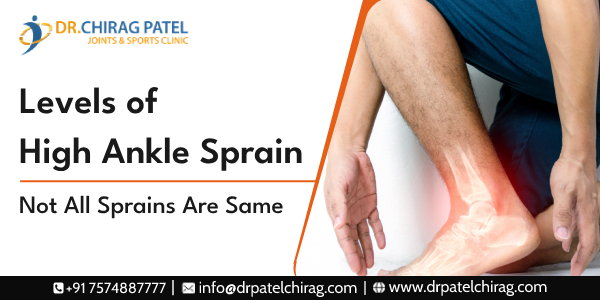Pain, swelling, bruising, and difficulty walking – a sprain in the ankle can single-handedly bring the quality of life down for days at a stretch. It may start as a little twinge in the ankle but soon develop into serious complications. “Chronic instability, functional limitations, tendon injuries, and even nerve damage can also happen in rare cases,” says orthopaedic specialist and foot and ankle surgeon in Mumbai Dr. Chirag Patel and about high ankle sprain.
Ankle Injury That Takes Longest to Heal
High ankle sprains due to twisting at the region above the ankle joint are more severe and take longer than all other types of ankle sprains. There are, again, levels to this ankle sprain, which may be based on the severity.
In this blog, with the guidance of an orthopaedic surgeon in Mumbai, Dr. Chirag Patel, we explain the levels of high ankle sprain to let you know the severity of the sprain and help you take necessary precautions as early as possible. Read on.
Levels of High Ankle Sprain & Their Symptoms:
High ankle sprain typically happens in the area above the ankle joint. It occurs when the ligaments that connect the tibia and fibula get damaged to cause an ankle injury. The levels of the high-level ankle sprain are graded based on the severity of the damage to the ligaments:
Grade 1: This is a mild level of high ankle pain when the ligaments are slightly stretched or mildly torn. The slight damage causes minimal swelling, pain, and discomfort while the joint stays stable.
Treatment begins with RICE (Rest, Ice, Compression, and elevation) to reduce swelling and pain.
Brace or boot support to enable healing and mobility exercises to improve mobility are introduced for grade 1 high ankle pain treatment.
Grade 2: The ligaments, in this case of the ankle sprain, are partially torn, resulting in moderate swelling, pain, or bruising. There might be some instability in the joint, leading to pain and difficulty walking.
Moderate sprains will require temporary immobilization to ensure healing. Physical therapy exercises and rehab to increase strength and recovery are prescribed, and weight-bearing is gradually introduced.
Grade 3: This is severe high ankle pain where the ligaments get completely torn, manifesting in severe swelling, pain, and bruising. As a result, the joint becomes unstable, weight-bearing could become difficult, and even standing could be painful.
RICE, immobilization, physical therapy, exercises to strengthen ankles, and rehab are recommended for healing and gaining strength. In severe cases, even surgery is considered to repair and restore function as a part of grade 3 high ankle pain treatment.
“High ankle sprains usually occur in sports that involve quick movements, sudden changes in direction, and heavy impact on heels. Ankle strengthening, proper warm-up and cool-down, adequate recovery, technique, and rest are the only ways to reduce the risk of high ankle sprains. But most importantly, it is always advised to consult a foot and ankle specialist as soon as an injury occurs to ensure proper treatment before it worsens,” says sports injury specialist and foot and ankle surgeon in Mumbai, Dr. Chirag Patel.





